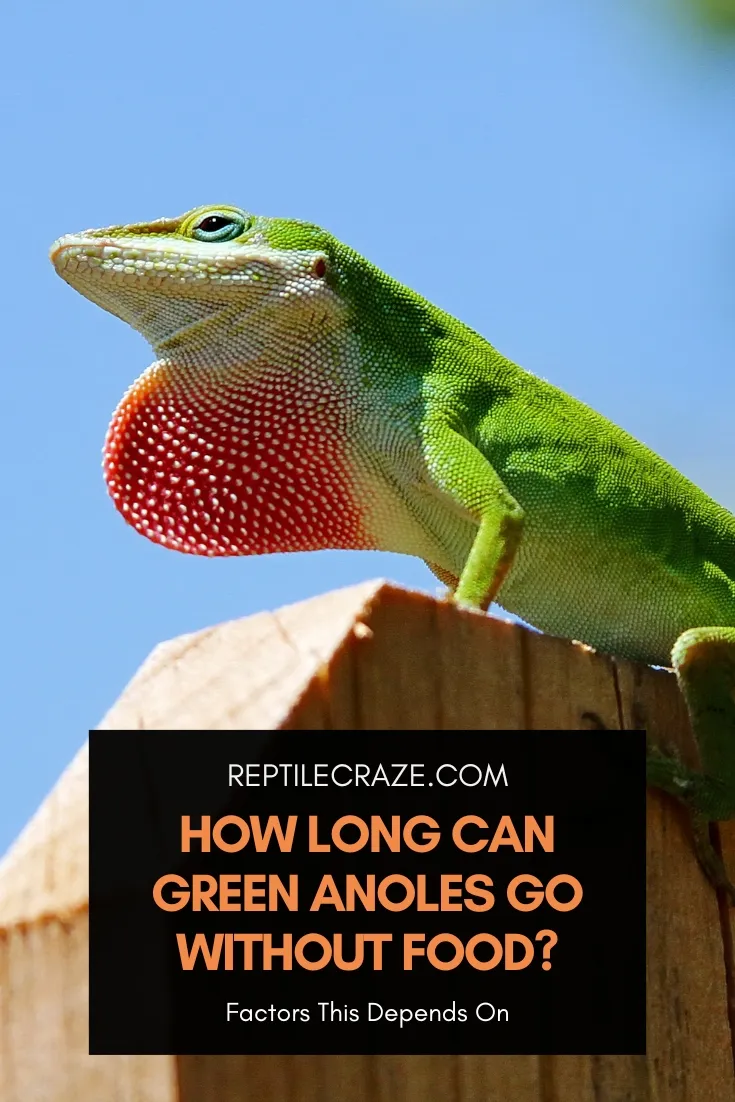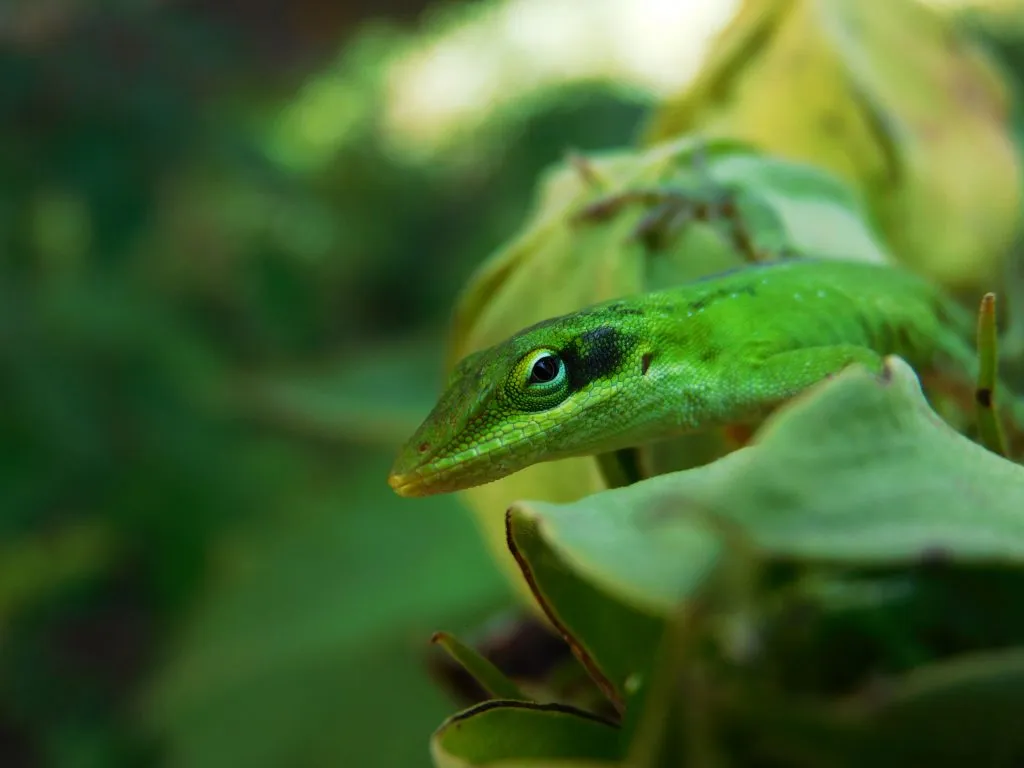
Did you just get a green anole and want to know their nutritional needs? Green anoles are highly adaptable in their
So the next question is how much time can they go without sustenance before it affects them negatively? Let’s explore this question further.
Healthy adult green anoles can go without
| ANOLE AGE | IN CAPTIVITY | IN THE WILD | |
| Baby | 2 weeks | 3 weeks | |
| Juvenile | 4 weeks | 6 weeks | |
| Adult | 4 weeks | 6 weeks |
However, many other factors may influence how long they can go without
Table of Contents
Factors That Determine How Long Green Anoles Can Go Without Food
Your green anole’s needs vary based on age, health, weight, stress, habitat, and shedding habits. Your green anole is unique to its species and will process food or respond to their environment differently from other lizards.
These factors determine the amount of time your anole can go without eating.
Age Affects the Anole’s Dietary Needs

Age has been established as one of the main factors determining how long a green anole can go without
Babies need two meals a day to help them grow healthy and strong. Juveniles can get by with one meal daily, and adults can get by eating every two days.
An anole’s appetite may vary based on the following:
- Activity level
- UVA/UVB availability
- Calories in the
food - Condition of the lighting
Green anoles eat insects, including spiders, crickets, flies, and beetles. However, like humans, they like variety, and the occasional mealworm is a welcome treat.
Tip: Read our Green Anole Care Guide to learn how to take proper care of these beautiful lizards!
Pregnancy Changes Their Nutritional Needs
Pregnancy changes the anole’s nutritional needs, and they will require more nutrients. Pregnant anoles should be dusted with calcium supplements and vitamin supplements.
Note: Usually, anoles should have calcium added to their
food two times per week.
D3 is also significant to pregnant anoles, as it helps with egg formation. UVB lighting encourages the production of calcium and vitamin D3.
You can tell an anole is pregnant if her belly gets more prominent on the side. Her weight and belly will likely grow very quickly.
The gestation period of the green anole is about five to seven weeks. However long the pregnancy lasts, the lizard will need more nutrients.
When the Anole Brumates, They Slow Down
When the anole is brumating, it is usually slow and inactive. They do not eat, but they do need to keep themselves hydrated. Brumation protects them from the lack of resources that occurs during the winter.
Insects and plant life become scarce, and their bodies naturally slow down. The caloric intake of the anole during this time is sparse. Anoles typically brumate for two to three months starting in the fall.
In the spring, they become active, and their metabolism returns to normal. You can set the scene for your captive anole to brumate by reducing the temperature to 65 to 70 degrees Fahrenheit.
The temperature should be decreased to about 60 degrees at night. This temperature ensures that they will brumate and want less
Health Can Be a Dealbreaker

If your anole is sick, do not allow them to go without
However, that is no excuse not to try and feed it. Some of the various health conditions that your anole may be experiencing that can exacerbate a poor appetite:
- Intestinal issue
- Respiratory illness
- Skin infection
- Swollen joints
You can tell if an anole is sick if they have discharge from their eyes, nose, or mouth. They may also have trouble shedding their skin. The good news is that anoles do not often get sick.
Weight is More Than Just a Number
Female anoles are usually smaller than males. There are heavy weights and lightweight anoles. In general, adult anoles typically weigh between two to six grams, while babies weigh about 0.27 grams when they are born.
These babies are miniature versions of adult anoles; what these little anoles lack in size, they make up for it in cuteness.
The larger the lizard, the longer it can go without
Shedding Precipitates Decreased Appetite
Green anoles shed their skin several times a year. On average, they tend to shed every four to six weeks. During this time, they usually stop eating one to three days before shedding.
In preparation for shedding, the anole will change color. They go from dull to bright green once the shedding is over, and they may not eat for a day or two afterward.
Stress Can Affect Their Food Needs

At some point during your anoles’ life, you may see that their normally vibrant green color turns brown. This transformation is a sign of severe stress.
Stress can cause them to not eat for a long time. However, your anole should eat to help maintain a healthy immune system and restore damaged cells.
The energy from the
- Changes in temperature
- Poor lighting
- Overcrowding
- Lack of
food and water
Another sign your anole is stressed is if they shed their skin excessively or hide for an extended time. In severe instances, stress can even cause death.
Keep your anole healthy by offering them enough
Habitat Dictates Nutritional Needs
Whether the anole is in the wild or captivity makes a big difference in how long they can go without
Captive anoles require more nutrition as their bodies are used to eating
When the weather is cool or colder, wild anoles conserve their
Anoles that live in captivity do not get a cooler period, as we tend to keep them warm, and they are more active, which means they must be fed regularly.
When these little green darlings become pets, hunting for
They do not need to worry about where they will get their next meal.
If the anole can get their
Another factor to consider is that green anoles do not eat if their habitat is not properly heated. Anoles are cold-blooded, and they need supplemental heat to be able to digest their
Conclusion
Green anoles are extraordinary and resourceful creatures. They can go for more extended periods without
Age, habitat, health, weight, stress, and shedding habits often affect how long they can go without
Anoles also do not require as many calories during brumation, which is similar to hibernation in that they slow down.
However, if your green anole demonstrates stress or discomfort, you should contact your veterinarian for guidance.
- Enchi Ball Python: A Unique and Stunning Morph of Python regius - March 27, 2025
- Emerald Tree Monitor: The Enigmatic Green Guardian of the Rainforest - March 26, 2025
- The Egyptian Cobra (Naja haje): A Fascinating Serpent - March 25, 2025
